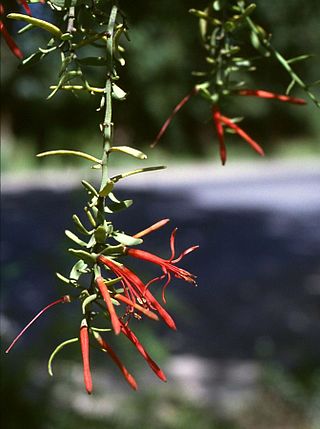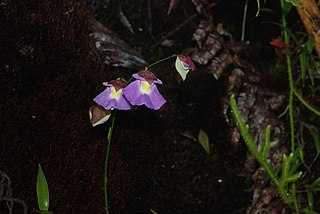
Loranthaceae, commonly known as the showy mistletoes, is a family of flowering plants. It consists of about 75 genera and 1,000 species of woody plants, many of them hemiparasites. The three terrestrial species are Nuytsia floribunda, Atkinsonia ligustrina, and Gaiadendron punctatum Loranthaceae are primarily xylem parasites, but their haustoria may sometimes tap the phloem, while Tristerix aphyllus is almost holoparasitic. For a more complete description of the Australian Loranthaceae, see Flora of Australia onlineArchived 2018-04-01 at the Wayback Machine., for the Malesian Loranthaceae see Flora of Malesia.

Soliva sessilis is a species of flowering plant in the family Asteraceae. It is one of up to nine species of the genus Soliva and is a low-growing herbaceous annual plant. Its common names include field burrweed, Onehunga-weed, lawn burrweed, lawnweed, jo-jo weed and common soliva. It is one of several plants also known as bindi weed, bindii, or bindi-eye.

Toxicodendron striatum is a South American poisonous tree in the family Anacardiaceae. It is commonly called manzanillo and grows in the tropical rain forests on low elevation slopes.

Iriartea is a genus in the palm family Arecaceae. It is native to Central and South America. The best-known species – and probably the only one – is Iriartea deltoidea, which is found from Nicaragua, south into Bolivia and a great portion of Western Amazonian basin. It is the most common tree in many forests in which it occurs.
Aegiphila cordifolia is a species of flowering plant in the family Lamiaceae. It is endemic to Peru, where it occurs in the Amazon rainforest. It is sometimes found in disturbed habitat.

Citronella mucronata, the huillipatagua, naranjillo, or Chilean citronella tree, is an evergreen tree in the family Cardiopteridaceae. It is endemic to Chile and grows in the Chilean matorral region of central Chile from 30º to 40° south latitude.

Utricularia unifolia is a species of perennial, medium-sized carnivorous plant that belongs to the family Lentibulariaceae. U. unifolia is native to Central America and western South America. It was originally published and described by Hipólito Ruiz López and José Antonio Pavón Jiménez in 1797 and later considered a synonym of Utricularia alpina until Peter Taylor's 1989 monograph on the genus where he restored the species as distinct from U. alpina. It grows as a terrestrial or epiphytic plant on moss-covered trees, rocks, or banks in cloud forests at altitudes between 2,000 m (6,562 ft) and 3,000 m (9,843 ft). U. unifolia usually produces only one leaf, which is where the species epithet "unifolia" is derived from.

Porlieria is a genus of flowering plants in the caltrop family, Zygophyllaceae. Species within this genus are shrubs or small trees of dry subtropical regions. The generic name honours Spanish ambassador Don Antonio Porlier de Baxamar.

Chondrodendron tomentosum is one of six accepted species in the small genus Chondrodendron, belonging to the Moonseed family Menispermaceae. It is a large tropical liana native to Central and South America. It contains highly toxic alkaloids and is one of the sources of the arrow poison curare – specifically 'tube curare', the name of which is derived from the name of the medicinally valuable alkaloid tubocurarine.

Tillandsia capillaris is a species of flowering plant in the family Bromeliaceae. This species is native to southern and western South America.

Carludovica palmata is a species of flowering plant in the family Cyclanthaceae. It is not a true palm, but its leaves are very similar compared to the leaves of some true palms, for example, to Chelyocarpus ulei. Unlike several true palms, C. palmata does not develop a woody trunk. Its female flowers have large stigmas, and its male flowers have a lot of pollen.

Cavanillesia umbellata is a species of trees in the family Malvaceae. It is native to South America.
Tabernaemontana sananho is a tropical tree species in the family Apocynaceae known as lobo sanango. Lobo sanango grows in the Amazon Basin of northern South America.

Escallonia resinosa is a species of evergreen shrub or tree in the family Escalloniaceae. It is native to the Andean forests of Peru, Bolivia and southern Ecuador from 2600 to 4200 meters above sea level. A component of high Andean forests, it is regarded as an important source of raw materials for the Andean peoples.

Fuchsia denticulata is a species of shrub in the family Onagraceae. It is native to Bolivia and Peru.

Escallonia paniculata is a species of tree in the family Escalloniaceae. It is native to Costa Rica, Panama and South America.

Persea caerulea is a species of evergreen tree in the laurel family, Lauraceae. It is native to North and South America.

Hedyosmum racemosum is a species of tree in the family Chloranthaceae. It is native to South America.
Godoya obovata is a species of tree in the family Ochnaceae. It is native to South America.

Campomanesia lineatifolia is a species of plant in the family Myrtaceae. Common names include guabiraba and perfume guava.


















